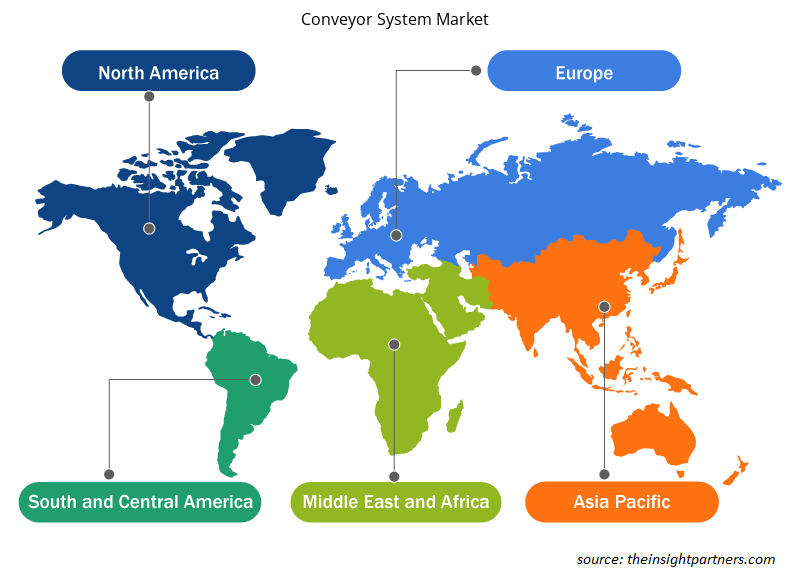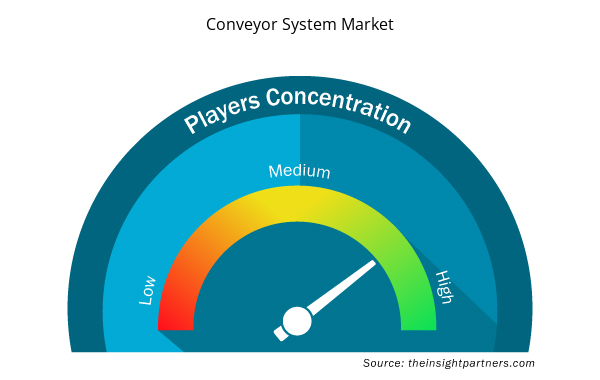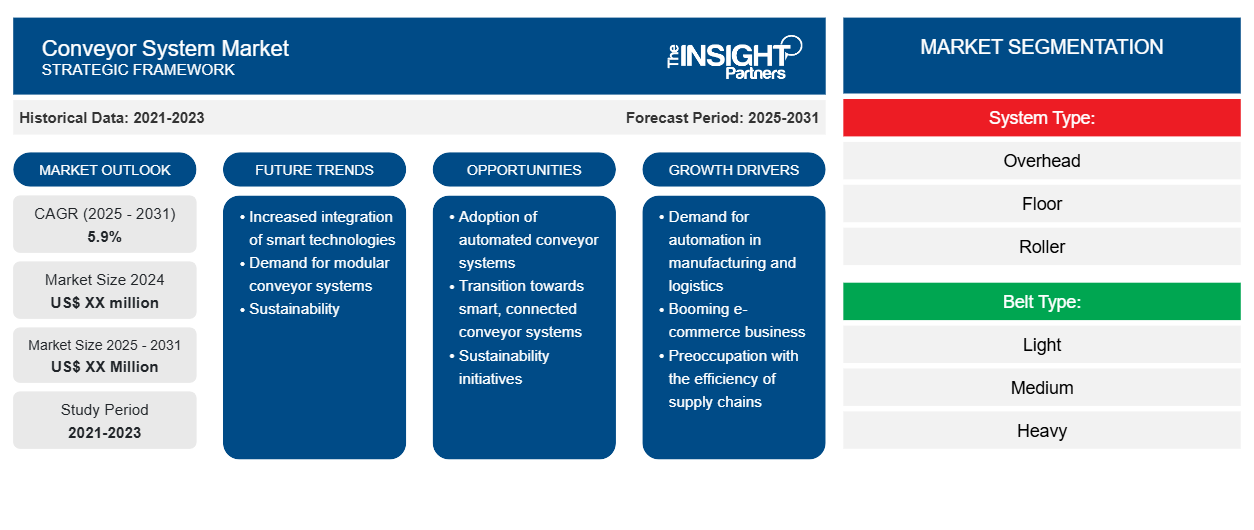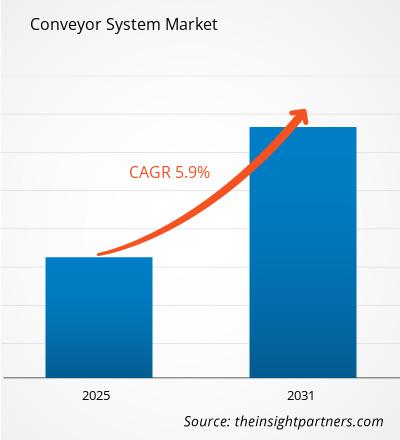Si prevede che il mercato dei sistemi di trasporto registrerà un CAGR del 5,9% dal 2024 al 2031, con una dimensione di mercato in espansione da XX milioni di dollari nel 2024 a XX milioni di dollari entro il 2031.
Questo rapporto di ricerca sul mercato dei sistemi di trasporto include analisi approfondite dello stato e delle prospettive di questo settore piuttosto importante, sottolineando tendenze e opportunità che spingerebbero in avanti i segmenti del mercato. Il rapporto categorizza il mercato in base al tipo di sistema, al tipo di cinghia e al settore dell'utente finale, fornendo così informazioni approfondite sulla mutevolezza del mercato, sulle preferenze dei consumatori e sui modelli di consumo in vari settori.
Questo studio esamina la tendenza dell'automazione nella produzione e nella logistica che definisce la domanda di sistemi di trasporto, che migliorano l'efficienza e la produttività delle operazioni. Studia vari tipi di trasportatori, tra cui nastri, rulli e sistemi modulari applicati in settori diversificati come automotive, food and beverage, magazzinaggio e distribuzione.
Inoltre, la segmentazione include informazioni sui settori da parte degli utenti finali, descrivendo come i requisiti diversificati modellano l'adozione di soluzioni di trasporto. Inoltre, il documento esamina i canali di vendita che coprono vendite dirette, distributori e piattaforme di e-commerce che rivelerebbero strategie efficaci per la penetrazione del mercato e il coinvolgimento dei clienti.
Scopo del rapporto
Il report Conveyor System Market di The Insight Partners mira a descrivere il panorama attuale e la crescita futura, i principali fattori trainanti, le sfide e le opportunità. Ciò fornirà spunti a vari stakeholder aziendali, come:
- Fornitori/produttori di tecnologia: per comprendere le dinamiche di mercato in evoluzione e conoscere le potenziali opportunità di crescita, consentendo loro di prendere decisioni strategiche informate.
- Investitori: condurre un'analisi completa delle tendenze in merito al tasso di crescita del mercato, alle proiezioni finanziarie del mercato e alle opportunità esistenti lungo la catena del valore.
- Enti di regolamentazione: regolamentano le politiche e le attività di controllo sul mercato allo scopo di ridurre al minimo gli abusi, preservare la fiducia degli investitori e sostenere l'integrità e la stabilità del mercato.
Segmentazione del mercato dei sistemi di trasporto
Tipo di sistema:
- Spese generali
- Pavimento
- Rullo
- Cintura
- Altri
Tipo di cintura:
- Leggero
- Medio
- Pesante
Industria:
- Cibo e bevande
- Automobilistico
- Aeroporti
- Logistica
- Metalli e estrazione mineraria
- Altri
Geografia
- America del Nord
- Europa
- Asia-Pacifico
- America del Sud e Centro
- Medio Oriente e Africa
Personalizza questo report in base alle tue esigenze
Riceverai la personalizzazione gratuita di qualsiasi report, comprese parti di questo report, o analisi a livello nazionale, pacchetto dati Excel, oltre a usufruire di grandi offerte e sconti per start-up e università
- Scopri le principali tendenze di mercato in questo rapporto.Questo campione GRATUITO includerà analisi di dati che spaziano dalle tendenze di mercato alle stime e alle previsioni.
Fattori trainanti della crescita del mercato dei sistemi di trasporto
- Domanda di automazione nella produzione e nella logistica: c'è una domanda crescente di automazione nella produzione e nella logistica. I sistemi di trasporto automatizzati sono diventati aspetti imperativi negli sforzi delle aziende per aumentare la loro efficienza operativa e ridurre i costi di manodopera. Questo aspetto può essere visto più chiaramente in settori come l'automotive, l'alimentare e le bevande e i prodotti farmaceutici, dove i processi semplificati sono cruciali.
- Attività di e-commerce in forte espansione: la crescita degli acquisti online ha visto le aziende investire massicciamente nell'automazione dei magazzini come mezzo per mantenere il controllo dei volumi di ordini in crescita, soddisfacendo allo stesso tempo le aspettative di tempi di consegna più lunghi. A questo proposito, i sistemi di trasporto fanno parte del nucleo stesso della catena logistica, consentendo alle aziende di smistare gli ordini molto più rapidamente e con un grado di accuratezza maggiore per tenere il passo con la soddisfazione dei consumatori in mezzo a una concorrenza agguerrita.
- Preoccupazione per l'efficienza delle supply chain: la preoccupazione contribuisce all'adozione diffusa di sistemi di trasporto. La domanda in continua crescita da parte dei consumatori ha reso le industrie consapevoli che devono lavorare per rendere più fluidi i flussi di lavoro di produzione. Pertanto, le aziende sono in grado di migliorare la movimentazione dei materiali, ridurre i colli di bottiglia operativi e aumentare la produttività con l'uso di soluzioni di trasporto.
- Tecnologie avanzate: i progressi tecnologici incoraggiano una maggiore crescita del mercato. Le tecnologie intelligenti sono integrate nei processi di IoT e AI per il monitoraggio in tempo reale dei sistemi di trasporto e la manutenzione predittiva. Migliorano inoltre l'operabilità per tempi di inattività inferiori e consentono operazioni aziendali fluide ed efficaci.
Tendenze future del mercato dei sistemi di trasporto
- Maggiore integrazione delle tecnologie intelligenti: tecnologie come IoT e AI costituiscono probabilmente una delle tendenze più attive degli ultimi anni. Tutte queste consentono monitoraggio in tempo reale, manutenzione predittiva e miglioramenti nell'efficienza operativa che consentiranno alle aziende di ottenere l'ottimizzazione dei processi con tempi di inattività ridotti.
- Domanda di sistemi di trasporto modulari: tali sistemi di trasporto modulari facilitano flessibilità e scalabilità, consentendo alle aziende di adattarsi facilmente e rapidamente ai cambiamenti nelle esigenze di produzione e di scalare le proprie operazioni senza ricorrere a grandi ristrutturazioni. Pertanto, tale scalabilità è particolarmente abbracciata in settori come l'e-commerce e la produzione, dove i requisiti possono variare in qualsiasi momento.
- Sostenibilità: anche la sostenibilità si rivela un obiettivo critico; sempre più aziende cercano soluzioni di trasporto efficienti dal punto di vista energetico. I produttori stanno elaborando progetti ecosostenibili che ridurranno il consumo energetico e le emissioni di carbonio, coincidendo quindi con gli obiettivi più ampi di sostenibilità aziendale.
Opportunità di mercato per i sistemi di trasporto
- Adozione di sistemi di trasporto automatizzati: con le aziende che cercano di aumentare l'efficienza e ridurre al minimo i costi operativi. Ciò diventa particolarmente evidente in settori come l'e-commerce e la produzione, dove la necessità di evasione degli ordini è molto rapida e i processi devono essere il più fluidi possibile. Con una proiezione delle vendite dell'e-commerce che supereranno i 6 trilioni di $ entro il 2024, la necessità di mezzi efficienti di soluzioni di movimentazione dei materiali non può essere più forte.
- Transizione verso sistemi di trasporto intelligenti e connessi: con tecnologie integrate come Internet of Things e intelligenza artificiale che consentiranno il monitoraggio in tempo reale e la manutenzione predittiva. Ciò può migliorare notevolmente l'efficienza operativa delle aziende e ridurre i loro livelli di tempi di inattività. Il mercato dell'IoT nei sistemi di trasporto dovrebbe crescere a un ritmo sostanziale, una caratteristica che riflette il forte interesse degli investitori in queste innovazioni.
- Iniziative di sostenibilità: poiché le industrie si concentrano sempre di più sulla riduzione del loro impatto ambientale, le soluzioni di trasporto a basso consumo energetico hanno iniziato ad acquisire importanza. I sistemi ecocompatibili che risparmiano energia comportano enormi risparmi sui costi e tali soluzioni sono interessanti per le aziende che mirano a migliorare i loro profili di sostenibilità.
Approfondimenti regionali sul mercato dei sistemi di trasporto
Le tendenze regionali e i fattori che influenzano il mercato dei sistemi di trasporto durante il periodo di previsione sono stati ampiamente spiegati dagli analisti di Insight Partners. Questa sezione discute anche i segmenti e la geografia del mercato dei sistemi di trasporto in Nord America, Europa, Asia Pacifico, Medio Oriente e Africa e America meridionale e centrale.

- Ottieni i dati specifici regionali per il mercato dei sistemi di trasporto
Ambito del rapporto di mercato del sistema di trasporto
| Attributo del report | Dettagli |
|---|---|
| Dimensioni del mercato nel 2024 | XX milioni di dollari USA |
| Dimensioni del mercato entro il 2031 | XX milioni di dollari USA |
| CAGR globale (2025 - 2031) | 5,9% |
| Dati storici | 2021-2023 |
| Periodo di previsione | 2025-2031 |
| Segmenti coperti | Per tipo di sistema:
|
| Regioni e Paesi coperti | America del Nord
|
| Leader di mercato e profili aziendali chiave |
|
Densità dei player del mercato dei sistemi di trasporto: comprendere il suo impatto sulle dinamiche aziendali
Il mercato dei sistemi di trasporto sta crescendo rapidamente, spinto dalla crescente domanda degli utenti finali dovuta a fattori quali l'evoluzione delle preferenze dei consumatori, i progressi tecnologici e una maggiore consapevolezza dei vantaggi del prodotto. Con l'aumento della domanda, le aziende stanno ampliando le loro offerte, innovando per soddisfare le esigenze dei consumatori e capitalizzando sulle tendenze emergenti, il che alimenta ulteriormente la crescita del mercato.
La densità degli operatori di mercato si riferisce alla distribuzione di aziende o società che operano in un particolare mercato o settore. Indica quanti concorrenti (operatori di mercato) sono presenti in un dato spazio di mercato in relazione alle sue dimensioni o al valore di mercato totale.
Le principali aziende che operano nel mercato dei sistemi di trasporto sono:
- Società anonima
- Dematico
- Emerson Electric Co
- Honeywell Intelligered
- Interroll Holding GmbH
Disclaimer : le aziende elencate sopra non sono classificate secondo un ordine particolare.

- Ottieni una panoramica dei principali attori del mercato dei sistemi di trasporto
Punti di forza chiave
- Copertura completa: il rapporto copre in modo completo l'analisi di prodotti, servizi, tipologie e utenti finali del mercato dei sistemi di trasporto, fornendo una panoramica olistica.
- Analisi degli esperti: il rapporto è compilato sulla base della conoscenza approfondita di esperti e analisti del settore.
- Informazioni aggiornate: il rapporto garantisce la pertinenza aziendale grazie alla copertura di informazioni recenti e tendenze nei dati.
- Opzioni di personalizzazione: questo report può essere personalizzato per soddisfare le esigenze specifiche del cliente e adattarsi in modo appropriato alle strategie aziendali.
Il rapporto di ricerca sul mercato dei sistemi di trasporto può, quindi, aiutare a guidare il percorso di decodifica e comprensione dello scenario del settore e delle prospettive di crescita. Sebbene possano esserci alcune preoccupazioni valide, i vantaggi complessivi di questo rapporto tendono a superare gli svantaggi.
- Analisi storica (2 anni), anno base, previsione (7 anni) con CAGR
- Analisi PEST e SWOT
- Valore/volume delle dimensioni del mercato - Globale, regionale, nazionale
- Industria e panorama competitivo
- Set di dati Excel



Report Coverage
Revenue forecast, Company Analysis, Industry landscape, Growth factors, and Trends

Segment Covered
This text is related
to segments covered.

Regional Scope
North America, Europe, Asia Pacific, Middle East & Africa, South & Central America

Country Scope
This text is related
to country scope.
Domande frequenti
The report can be delivered in PDF/PPT format; we can also share excel dataset based on the request.
Some of the customization options available based on request are additional 3-5 company profiles and country-specific analysis of 3-5 countries of your choice. Customizations are to be requested/discussed before making final order confirmation, as our team would review the same and check the feasibility.
The market is expected to register a CAGR of 5.9% during 2023-2031
In a nutshell, the driving forces of the Conveyor System Market include demand from automation, growth in e-commerce, efficiency in supply chains, technological advancement, and environmental concerns. These factors together create a dynamic landscape that positions the market for continued growth in the coming years.
Increased automation of warehouses and distribution centers, therefore, drives investment in advanced conveyor technologies. Also, automated systems will be unavoidable to handle the increased volume of orders and for improving the efficiency of overall logistics. As these trends continue to evolve, the Conveyor System Market is poised for sustained growth, meeting the demands of a rapidly changing industrial landscape.
The key players in conveyor system market are - Daifuku Co Ltd, Dematic, Emerson Electric Co, Honeywell Intelligrated, Interroll Holding GmbH, Siemens AG, SSI Schafer, Swisslog Holding AG, TGW Logistics Group
Trends and growth analysis reports related to Manufacturing and Construction : READ MORE..
The List of Companies - Conveyor System Market
- Daifuku Co., Ltd.
- Dematic
- Emerson Electric Co
- Honeywell Intelligrated
- Interroll Holding GmbH
- Siemens AG
- SSI Schafer
- Swisslog Holding AG
- TGW Logistics Group
- Vanderlande Industries B.V
The Insight Partners performs research in 4 major stages: Data Collection & Secondary Research, Primary Research, Data Analysis and Data Triangulation & Final Review.
- Data Collection and Secondary Research:
As a market research and consulting firm operating from a decade, we have published and advised several client across the globe. First step for any study will start with an assessment of currently available data and insights from existing reports. Further, historical and current market information is collected from Investor Presentations, Annual Reports, SEC Filings, etc., and other information related to company’s performance and market positioning are gathered from Paid Databases (Factiva, Hoovers, and Reuters) and various other publications available in public domain.
Several associations trade associates, technical forums, institutes, societies and organization are accessed to gain technical as well as market related insights through their publications such as research papers, blogs and press releases related to the studies are referred to get cues about the market. Further, white papers, journals, magazines, and other news articles published in last 3 years are scrutinized and analyzed to understand the current market trends.
- Primary Research:
The primarily interview analysis comprise of data obtained from industry participants interview and answers to survey questions gathered by in-house primary team.
For primary research, interviews are conducted with industry experts/CEOs/Marketing Managers/VPs/Subject Matter Experts from both demand and supply side to get a 360-degree view of the market. The primary team conducts several interviews based on the complexity of the markets to understand the various market trends and dynamics which makes research more credible and precise.
A typical research interview fulfils the following functions:
- Provides first-hand information on the market size, market trends, growth trends, competitive landscape, and outlook
- Validates and strengthens in-house secondary research findings
- Develops the analysis team’s expertise and market understanding
Primary research involves email interactions and telephone interviews for each market, category, segment, and sub-segment across geographies. The participants who typically take part in such a process include, but are not limited to:
- Industry participants: VPs, business development managers, market intelligence managers and national sales managers
- Outside experts: Valuation experts, research analysts and key opinion leaders specializing in the electronics and semiconductor industry.
Below is the breakup of our primary respondents by company, designation, and region:

Once we receive the confirmation from primary research sources or primary respondents, we finalize the base year market estimation and forecast the data as per the macroeconomic and microeconomic factors assessed during data collection.
- Data Analysis:
Once data is validated through both secondary as well as primary respondents, we finalize the market estimations by hypothesis formulation and factor analysis at regional and country level.
- Macro-Economic Factor Analysis:
We analyse macroeconomic indicators such the gross domestic product (GDP), increase in the demand for goods and services across industries, technological advancement, regional economic growth, governmental policies, the influence of COVID-19, PEST analysis, and other aspects. This analysis aids in setting benchmarks for various nations/regions and approximating market splits. Additionally, the general trend of the aforementioned components aid in determining the market's development possibilities.
- Country Level Data:
Various factors that are especially aligned to the country are taken into account to determine the market size for a certain area and country, including the presence of vendors, such as headquarters and offices, the country's GDP, demand patterns, and industry growth. To comprehend the market dynamics for the nation, a number of growth variables, inhibitors, application areas, and current market trends are researched. The aforementioned elements aid in determining the country's overall market's growth potential.
- Company Profile:
The “Table of Contents” is formulated by listing and analyzing more than 25 - 30 companies operating in the market ecosystem across geographies. However, we profile only 10 companies as a standard practice in our syndicate reports. These 10 companies comprise leading, emerging, and regional players. Nonetheless, our analysis is not restricted to the 10 listed companies, we also analyze other companies present in the market to develop a holistic view and understand the prevailing trends. The “Company Profiles” section in the report covers key facts, business description, products & services, financial information, SWOT analysis, and key developments. The financial information presented is extracted from the annual reports and official documents of the publicly listed companies. Upon collecting the information for the sections of respective companies, we verify them via various primary sources and then compile the data in respective company profiles. The company level information helps us in deriving the base number as well as in forecasting the market size.
- Developing Base Number:
Aggregation of sales statistics (2020-2022) and macro-economic factor, and other secondary and primary research insights are utilized to arrive at base number and related market shares for 2022. The data gaps are identified in this step and relevant market data is analyzed, collected from paid primary interviews or databases. On finalizing the base year market size, forecasts are developed on the basis of macro-economic, industry and market growth factors and company level analysis.
- Data Triangulation and Final Review:
The market findings and base year market size calculations are validated from supply as well as demand side. Demand side validations are based on macro-economic factor analysis and benchmarks for respective regions and countries. In case of supply side validations, revenues of major companies are estimated (in case not available) based on industry benchmark, approximate number of employees, product portfolio, and primary interviews revenues are gathered. Further revenue from target product/service segment is assessed to avoid overshooting of market statistics. In case of heavy deviations between supply and demand side values, all thes steps are repeated to achieve synchronization.
We follow an iterative model, wherein we share our research findings with Subject Matter Experts (SME’s) and Key Opinion Leaders (KOLs) until consensus view of the market is not formulated – this model negates any drastic deviation in the opinions of experts. Only validated and universally acceptable research findings are quoted in our reports.
We have important check points that we use to validate our research findings – which we call – data triangulation, where we validate the information, we generate from secondary sources with primary interviews and then we re-validate with our internal data bases and Subject matter experts. This comprehensive model enables us to deliver high quality, reliable data in shortest possible time.


 Ottieni un campione gratuito per questo repot
Ottieni un campione gratuito per questo repot